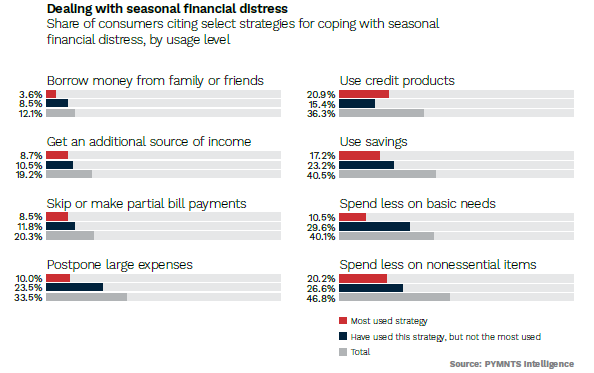Nearly Half of Consumers Curtail Nonessential Spending to Tackle Holiday-Induced Financial Stress

The holiday season is a time of joy and celebration, but it can also be a time of intense financial stress for many consumers, especially those living paycheck to paycheck.
According to a new PYMNTS Intelligence report titled “New Reality Check: The Paycheck-to-Paycheck Report,” which examines how seasonal spending impacts consumers’ ability to manage expenses and accumulate savings, 55% of consumers facing seasonal swings cite events and celebrations as reasons for financial distress, with November and December being the most times of financial anxiety.

To tackle this issue, nearly half of consumers consider cutting back on nonessential spending as a strategy to alleviate seasonal financial stress, with about 1 in 5 consumers citing it is their top strategy.
Additionally, credit products, used by 36% of consumers experiencing seasonal financial stress, are cited as a coping strategy during the holidays, with nearly 21% of respondents consider this their top strategy.
As the report stated, “using credit to deal with seasonal financial distress is a popular strategy for all consumers. At 23%, paycheck-to-paycheck consumers without issues paying their bills cite credit product usage as their top strategy — slightly more than the 20% of paycheck-to-paycheck consumers struggling to pay bills and the 17% of consumers not living paycheck to paycheck who say the same.”
The report further reveals that consumers’ preferred financial management strategies differ based on their financial lifestyles. Non-paycheck-to-paycheck individuals are more inclined to rely on savings or cut back on nonessential spending, with both strategies equally favored at 26%.
On the other hand, paycheck-to-paycheck consumers with bill payment issues tend to resort to skipping or making partial payments (19%) and spending less on basic needs (14%). Struggling consumers, who face limited resources, are less likely to use savings (10%) or cut back on nonessential spending (13%), indicating their reliance on credit products.
These trends go to show that as the holiday season approaches, consumers will need to be aware of the various strategies available to manage financial distress. Cutting back on nonessential spending, utilizing credit products and dipping into savings will all prove critical in alleviating financial stress during a time of joy and celebration.
However, it is important for consumers to be mindful of the potential negative impact of relying on credit and to budget and save accordingly. By understanding these strategies and tailoring them to their individual financial lifestyles, they can navigate the holiday season with greater financial stability and peace of mind.

